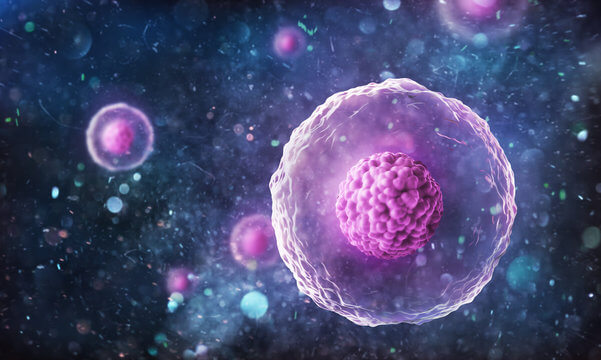Nucleus DefinitionIntroductionIn the context of biology, the term "nucleus" refers to a membrane-bound organelle that is present in most eukaryotic cells. It holds the DNA, arranged into chromosome-like formations that make up the cell's genetic material. The cell's control centre is the nucleus, regulating gene expression and controlling many functions. It is also responsible for cell division, where the DNA is replicated and distributed to daughter cells. The nucleus plays a vital role in eukaryotic organisms' growth, development, and reproduction. What is Nucleus DefinitionThe majority of animal cells contain the nucleus, an important organelle. It is a membrane-bound structure that contains the genetic material of the cell in the form of DNA, which is organized into chromosomes. The nucleus regulates gene expression, controls cell functions, and plays a crucial role in cell division. The double membrane that encloses the nucleus and separates it from the cytoplasm is known as the nuclear envelope. Nuclear pores in the membrane transfer molecules like RNA and proteins between the cytoplasm and nucleus. 
The nucleolus is a substructure within the nucleus that is involved in the production of ribosomes, which are essential for protein synthesis. The nucleus is critical in eukaryotic organisms' growth, development, and reproduction, making it a fundamental component of cell biology. Discovery of NucleusThe nucleus was discovered through a series of observations made by several scientists. In 1665, Robert Hooke observed small compartments he called "cells" in slices of cork, while in 1831, Robert Brown observed a small, darkly stained structure he called the "nucleus" inside the cells of orchid plants. Later, Walther Flemming used improved staining techniques to study cell division and proposed that the nucleus contained the cell's genetic material. These discoveries laid the foundation for our understanding of the structure and function of the nucleus, which is a membrane-bound organelle that houses the genetic material of eukaryotic cells. Occurrence of NucleusThe nucleus is a membrane-bound organelle in eukaryotic cells, including all multicellular organisms and some unicellular organisms such as yeast and protists. It houses the genetic material (DNA) of the cell and is typically located in the centre, surrounded by a double membrane called the nuclear envelope. Different nuclei may be present depending on the creature and sort of cell. For example, in plants, nuclei are present in all cells, while in animals, different cell types may have different numbers of nuclei or no nuclei at all (such as red blood cells). In general, the nucleus is an essential feature of eukaryotic cells, allowing for the regulation and expression of genetic information. Characteristics of NucleusThe nucleus is a highly specialized and complex structure, and it possesses several distinctive characteristics, including:
Size of NucleusThe organism, sort of cell, and cell cycle period can all affect the nucleus size. The nucleus is one of the largest organelles in eukaryotic cells, occupying anywhere from 10% to 30% of the total cell volume. The size of the nucleus can also vary between different cell types. For example, muscle cells can have large nuclei occupying a significant portion of the cell, while red blood cells have no nucleus. During the cell cycle, the nucleus's size can also change. During interphase, the period between cell divisions, the nucleus is typically spherical or oval-shaped and contains a chromatin network. During mitosis, the chromatin condenses into visible chromosomes, and the nucleus becomes more compact. Various factors, including the amount of DNA in the nucleus, the rate of protein synthesis, and the cell's overall metabolic activity, regulate the size of the nucleus. Structure of NucleusMost of an atom's mass and positive charge are located in the nucleus, the atom's core. It is composed of nucleons, which are protons and neutrons put together. There are three major parts to the nucleus' composition.
The number of protons and neutrons determines an atom's mass, while the number of protons in its nucleus defines its element. The stability of the atom is impacted by the configuration of the nucleons in the nucleus, which is another significant factor. The centre of an atom can become unstable and experience radioactive disintegration if it contains either too many or too few neutrons. Function of NucleusThe nucleus of an atom has several important functions, including:
The nucleus is a critical component of the cell and plays a vital role in regulating gene expression and maintaining cellular functions.
Next TopicPronoun Ki Definition
|
 For Videos Join Our Youtube Channel: Join Now
For Videos Join Our Youtube Channel: Join Now
Feedback
- Send your Feedback to [email protected]
Help Others, Please Share










